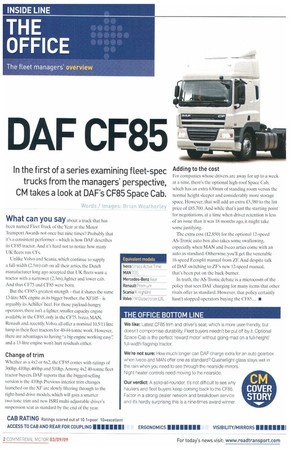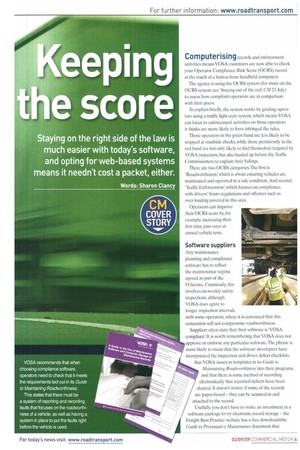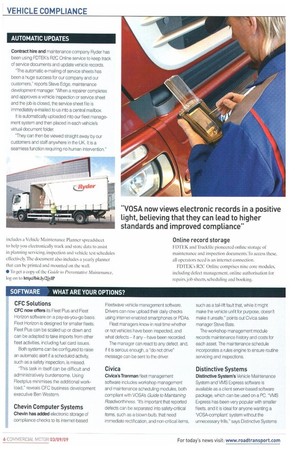OAF CF85
Page 42

Page 45

Page 46

Page 47

If you've noticed an error in this article please click here to report it so we can fix it.
In the first of a series examining fleet-spec trucks from the managers' perspective, CM takes a look at DAF's CF85 Space Cab.
What can you say ahout a truck that has been named Fleet Truck of the Year at the Motor Transport Awards not once hut nine times? Probably that it's a consistent performer — which is how DAF describes its CF85 tractor. And it's hard not to notice how many UK fleets run CFs.
Unlike Volvo and Scania, which continue to supply a full-width (2.5m) cab on all their artics, the Dutch manufacturer long ago accepted that UK fleets want a tractor with a narrower (2.3m), lighter and lower cab. And thus CF75 and CF85 were born.
But the CF85's greatest strength — that it shares the same 13-litre MX engine as its bigger brother, the XFI05 — is arguably its Achilles' heel. For those payload-hungry operators, there isn't a lighter, smaller capacity engine available in the CE85, only in the CF75. Iveco, MAN, Renault and, recently, Volvo, all offer a nominal 10,5/11-litre lump in their fleet tractors for 40-44-tonne work. However, there are advantages to having "a big engine working easy': and a 13-litre engine won't hurt residuals either.
Change of trim
Whether as a 4x2 or 6x2, the CF85 comes with ratings of 360hp, 410hp, 460hp and 510hp. Among 4x2 40-tonne fleet tractor buyers, DAF reports that the biggest-selling version is the 410hp. Previous interior trim changes launched on the XF are slowly filtering through to the right-hand drive models, which will gain a smarter two-tone trim and new ISRI multi-adjustable driver's suspension seat as standard by the end of the year.
Adding to the cost
For companies whose drivers are away for up to a week at a thine, there's the optional high-roof Space Cab, which has an extra 630mm of standing room versus the normal height sleeper and considerably more storage space. However, that will add an extra /3,380 to the list price of £85,700. And while that's just the starting point for negotiations, at a time when driver retention is less of an issue than it was 18 months ago, it might take some justifying.
The extra cost (2.850) for the optional 12-speed AS-Tronic auto box also takes some swallowing, especially when MAN and Iveco artics come with an auto as standard. Otherwise, you'll get the venerable 16-speed Ecosplit manual from ZE And despite talk of DAF switching to ZF's new 12-speed manual, that's been put on the back-burner.
In truth, the AS-Tronic debate is a microcosm of the policy that sees DAF charging for many items that other rivals offer as standard. However. that policy certainly hasn't stopped operators buying the CF85... • Computerising records and enforcement activities means VOSA examiners are now able to check your Operator Compliance Risk Score (OCRS) record at the touch of a button from handheld computers.
The agency is using the OCRS system (for more on the OCRS system, see 'Staying out of the red'. CM 23 July) to assess how compliant operators are in comparison with their peers.
To explain briefly, the system works by grading operators using a traffic light-style system, which means VOSA can focus its enforcement activities on those operators it thinks are more likely to have infringed the rules.
Those operators in the green band are less likely to be stopped at roadside checks, while those persistently in the red band are not only likely to find themselves targeted by VOSA inspectors, but also hauled up before the Traffic Commissioners to explain their failings.
There are two OCRS categories. The first is 'Roadworthiness', which is about ensuring vehicles are maintained and operated in a safe condition. And second, 'Traffic Enforcement', which focuses on compliance, with drivers' hours regulations and offences such as over-loading covered in this area.
Operators can improve their OCRS score by, for example, increasing their first-time pass rates at annual vehicle tests.
Software suppliers
Any maintenance planning and compliance software has to reflect the maintenance regime agreed as part of the 0-licence. Commonly, this involves six-weekly safety inspections, although VOSA does agree to longer inspection intervals with some operators, where it is convinced that this concession will not compromise roadworthiness. Suppliers often state that their software is VOSA compliant: It is worth remembering that VOSA does not approve or endorse any particular software. The phrase is more likely to mean that the software developers have incorporated the inspection and driver defect checklists that VOSA issues as templates in its Guide to Maintaining Roadworthiness into their programs, and that there is some method of recording electronically that reported defects have been cleared. It doesn't matter if sonic of the records are paper-based — they can be scanned in and attached to the record.
Usefully, you don't have to make an investment in a software package to try electronic record storage — the Freight Best Practice website has a free down loadable Guide to Preventative Maintenance document that
includes a Vehicle Maintenance Planner spreadsheet to help you electronically track and store data to assist in planning servicing, inspection and vehicle test schedules effectively. The document also includes a yearly planner that can be printed and mounted on the wall.
• To get a copy of the Guide to Preventative Maintenance, log on to http://billy/2jy1P
Online record storage
1-D'IEK and Truckfile pioneered online storage of maintenance and inspection documents.To access these, all operators need is an internet connection.
FDTEK's R2C Online comprises nine core modules, including defect management. online authorisation for repairs, job sheets, scheduling and booking. There is a web-based maintenance scheduler with alerts for due and overdue events. Vehicle service schedules are automatically updated whenever an inspection record is uploaded on to the system. Workshops pay a monthly fee, while operators pay to register each vehicle.
The latest version of Trucktite is interactive. When maintenance is due,Truckfile contacts the vehicle owners and the repairers It can also automatically plan servicing of ancillary equipment such as tail-lifts, cranes and refrigeration, so that it occurs at the same time as a scheduled vehicle inspection or service.
Road Tech Computer Systems is developing an online system for compliance records to complement its popular Tachomastcr system for driver's hours and tachograph record management.
Similar to Tachornaster, Road Tech plans to provide free software, then charge operators £.1 per vehicle per week. The system is expected to enter the live environment before the end of 2009.
"Operators need up-to-the-minute records to stay compliant, including driver defect reports. Drivers will be able to record daily checks using a Personal Digital Assistant or even a smartphone," says managing director Derek Beevor.
• Below, we've listed some of the software companies that provide software systems to aid compliance.




































































































































